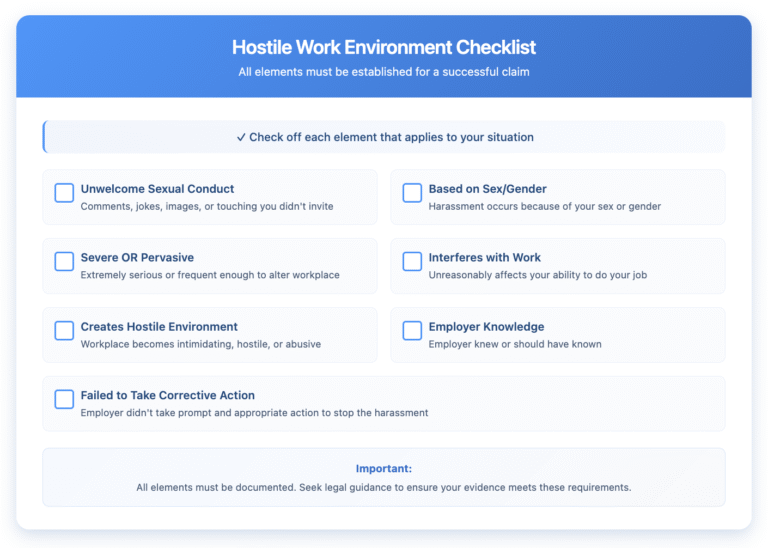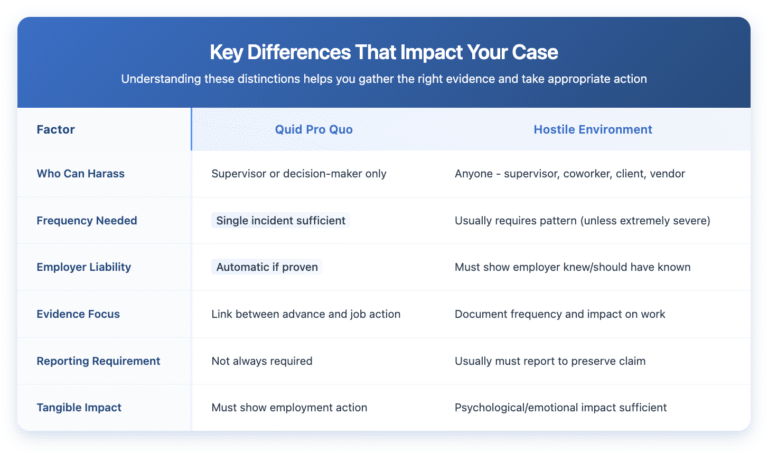If you’re experiencing unwanted sexual advances at work, knowing which type of harassment you’re facing directly impacts how you document it, report it, and protect your rights. This guide breaks down the two legally recognized forms of workplace sexual harassment – quid pro quo and hostile work environment – and shows you exactly what evidence you need for each type.
You’ll learn how to identify which type you’re experiencing, what makes each one illegal under federal law, and the specific steps to take right now to protect yourself.
Disclaimer: This article provides general information for informational purposes only and should not be considered a substitute for legal advice. It is essential to consult with an experienced employment lawyer at our law firm to discuss the specific facts of your case and understand your legal rights and options. This information does not create an attorney-client relationship.
Understanding Quid Pro Quo Sexual Harassment
Quid pro quo literally means “this for that.” In the workplace, it happens when someone with power over your job makes sexual demands in exchange for job benefits – or threatens job consequences if you refuse.
The key element? There’s a direct connection between the sexual advance and your employment status. Your supervisor doesn’t need to say the words explicitly. Courts recognize that these threats often come wrapped in suggestion rather than direct statements.

Think your situation might qualify? Here’s the critical point: even one incident of quid pro quo harassment violates federal law. You don’t need to show a pattern.
Recognizing Quid Pro Quo in Practice
The harassment doesn’t always look like what you see in movies. Modern quid pro quo harassment often appears more subtle.
Consider these scenarios that courts have recognized as quid pro quo harassment:
A manager suggests you’ll “go far” if you’re “friendly” to them outside work, then gives you poor performance reviews after you decline their invitations. That’s quid pro quo – even without explicit threats.
Your supervisor texts you repeatedly asking for dates, you politely refuse, and suddenly your overtime hours disappear. The connection between rejection and lost income establishes quid pro quo harassment.
Understanding Hostile Work Environment
Hostile work environment harassment works differently. Instead of a single decision-maker demanding sexual favors, you’re dealing with pervasive sexual conduct that makes it impossible to do your job effectively.
The legal standard requires showing that the harassment was severe or pervasive enough that a reasonable person would find the workplace hostile or abusive.
Breaking Down “Severe or Pervasive”
These two words carry a specific legal meaning:
Severe means the conduct was extremely serious – even one incident might qualify if it’s bad enough. Physical assault or explicit threats typically meet this standard.
Pervasive means the harassment happens frequently enough to alter your work environment. Daily sexual comments, even if individually “minor,” can create illegal harassment through their frequency.
Elements of Hostile Work Environment

The conduct doesn’t need to target you directly. Constant sexual jokes, displaying pornographic materials, or regular discussions about colleagues’ bodies can poison your work environment even if you’re not the subject.
Key Differences That Impact Your Case
Understanding these distinctions helps you gather the right evidence and take appropriate action:

This distinction matters because it determines your documentation strategy and reporting obligations.
When Both Types Overlap
Here’s where it gets complex: many situations involve both types of harassment. Your supervisor might make sexual advances (potential quid pro quo) while also creating a generally hostile environment through constant sexual comments.
Courts will analyze both theories. If your supervisor propositioned you once and you refused, that single incident might support a quid pro quo claim if you face retaliation. But if that same supervisor also makes daily sexual jokes and comments about women’s bodies, you’re also experiencing hostile environment harassment.
Documentation Strategies for Each Type
Your documentation approach should match the harassment type you’re experiencing.
For Quid Pro Quo:
Document the exact exchange. Save every email, text, or written communication where advances were made. Write down verbal propositions immediately, including:
- Date, time, and location
- Exact words used (as close as possible)
- Any witnesses present
- Your response
- Any job actions that followed
Create a timeline showing the connection between refusing advances and negative job consequences. If you declined dinner on March 1st and received a poor review on March 15th, that temporal proximity strengthens your case.
For Hostile Environment:
Focus on frequency and cumulative impact. Keep a detailed log of every incident, no matter how “small” it seems:

Take photos of offensive materials displayed in the workplace. Screenshot inappropriate emails or messages. Record how the environment affects your work performance, including sick days taken, projects affected, or changes in your productivity.
Reporting Requirements and Timelines
The EEOC requires you to file a charge within 180 days of the harassment (300 days in states with fair employment practices agencies, including New York). But here’s what many people don’t realize: the clock starts from the last incident, not the first.
For quid pro quo harassment, your 180/300 days typically begin when you suffer the adverse employment action – not when the proposition was made.
For hostile environment cases, each new incident potentially resets your filing deadline. However, waiting too long can weaken your case, especially if your employer argues you didn’t find the conduct unwelcome.
Internal Reporting: Your First Line of Defense
Before filing with the EEOC, check your employee handbook. Most employers have harassment policies requiring internal reports. Following these procedures:
- Preserves your legal claims
- Triggers your employer’s duty to investigate
- Creates a paper trail
- May resolve the situation without litigation
Report in writing, even if you also report verbally. Email creates timestamps and prevents “miscommunication” about what you reported.
Legal Standards from Key Cases
The Supreme Court established our current framework through several landmark cases. In Meritor Savings Bank v. Vinson (1986), the Court recognized both types of sexual harassment as sex discrimination under Title VII.
Burlington Industries v. Ellerth (1998) and Faragher v. City of Boca Raton (1998) clarified employer liability. For quid pro quo cases involving tangible employment actions, employers face strict liability. But for hostile environment cases, employers can assert an affirmative defense if they had reasonable preventive and corrective policies that you unreasonably failed to use.
Pennsylvania State Police v. Suders (2004) added that constructive discharge – when harassment becomes so intolerable you’re forced to quit – counts as a tangible employment action, potentially supporting a quid pro quo claim.
Building Your Strongest Case
Whether you’re facing quid pro quo or hostile environment harassment (or both), certain actions strengthen any sexual harassment claim:
Contemporaneous Documentation: Write everything down when it happens. Courts give more weight to contemporary records than later recollections.
Consistent Reporting: Tell someone – HR, a supervisor, a trusted colleague. Multiple consistent reports boost credibility.
Preserve Evidence: Don’t delete texts, emails, or voicemails, even if they’re upsetting. Forward copies to a personal email account you control.
Seek Support: Contact the EEOC or your state’s fair employment agency. They’ll explain your rights and may investigate at no cost.
Track Impact: Document how harassment affects your work and health. Keep medical records if you seek counseling or treatment for harassment-related stress.
Protecting Yourself from Retaliation
Federal law prohibits retaliation for reporting sexual harassment or participating in investigations. Retaliation includes any adverse action that would discourage a reasonable person from reporting harassment:
- Termination or demotion
- Pay cuts or reduced hours
- Unfavorable schedule changes
- Exclusion from meetings or projects
- Negative performance reviews
- Increased scrutiny or impossible deadlines
If you face retaliation after reporting harassment, that’s a separate legal violation – even if the underlying harassment claim doesn’t succeed.
Document retaliation just as carefully as the original harassment. Show the timeline between your protected activity (reporting) and the adverse action.
Next Steps: Taking Action Today
If you’re experiencing sexual harassment at work, here’s what to do right now:
- Identify the type: Review the distinctions above. Are you facing quid pro quo, hostile environment, or both?
- Start documenting: Begin your incident log today. Write down past incidents while your memory is fresh.
- Review policies: Read your employee handbook’s harassment and reporting policies tonight.
- Preserve evidence: Forward any relevant emails to a personal account. Screenshot text messages.
- Report appropriately: Follow your company’s reporting procedures, in writing when possible.
- Know your deadlines: Mark your calendar with EEOC filing deadlines based on the most recent incident.
- Get legal guidance: Sexual harassment cases involve complex legal standards and strict timelines.
How Nisar Law Can Help
Sexual harassment cases require strategic decisions about documentation, reporting, and timing. The distinction between quid pro quo and hostile environment harassment affects every aspect of your case – from what evidence matters most to whether your employer faces automatic liability.
At Nisar Law, we help employees navigate these complexities while protecting their careers and legal rights. We’ll analyze whether you’re facing one or both types of harassment, identify the strongest legal theories for your situation, and develop a strategic approach tailored to your goals.
Don’t wait until the harassment becomes unbearable or your filing deadlines pass. Contact Nisar Law today for a confidential consultation about your sexual harassment case. We’ll help you understand your rights, evaluate your options, and take decisive action to stop the harassment and hold your employer accountable.


